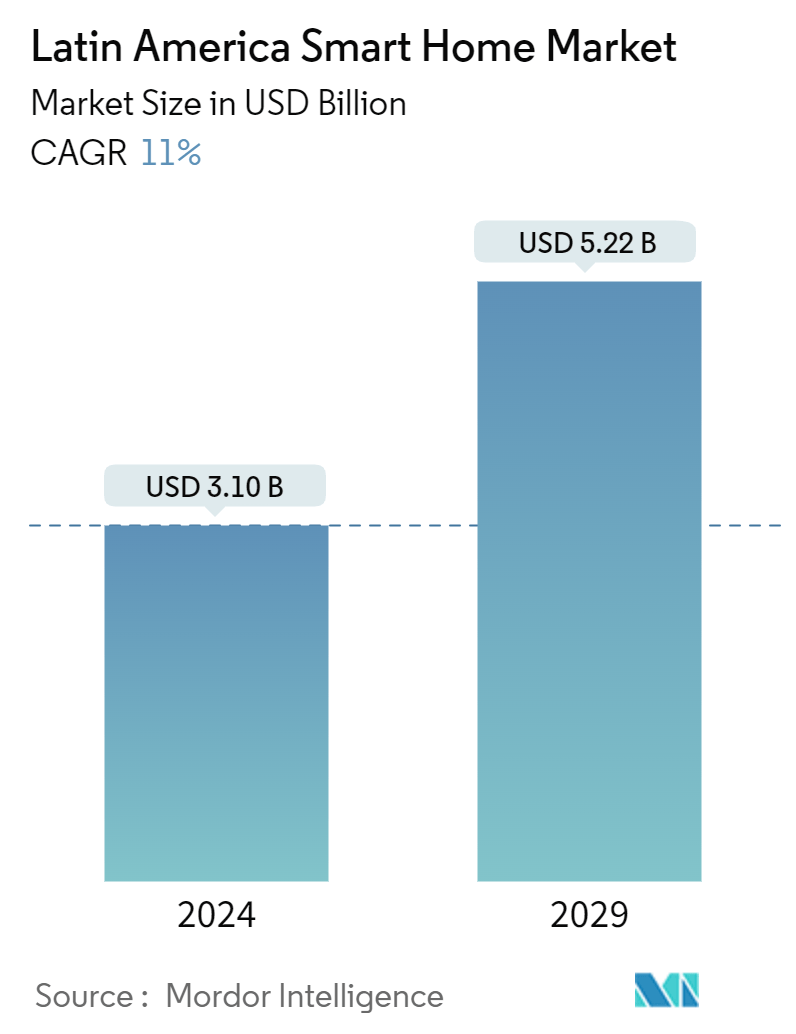Market Size of Latin America Smart Home Industry

| Study Period | 2019 - 2029 |
| Base Year For Estimation | 2023 |
| Market Size (2024) | USD 3.10 Billion |
| Market Size (2029) | USD 5.22 Billion |
| CAGR (2024 - 2029) | 11.00 % |
| Market Concentration | Low |
Major Players
*Disclaimer: Major Players sorted in no particular order |
Latin America Smart Home Market Analysis
The Latin America Smart Home Market size is estimated at USD 3.10 billion in 2024, and is expected to reach USD 5.22 billion by 2029, growing at a CAGR of 11% during the forecast period (2024-2029).
- The Latin American smart home market is witnessing a significant growth trajectory, fueled by increasing urbanization, technological advancements, and a rising middle class with higher disposable income. Although the market is still nascent compared to more developed regions, it is rapidly evolving.
- Urbanization is a significant driver; as cities expand and more people migrate to urban areas, there is a growing demand for smart solutions. Cities like Brazil, Mexico, and Argentina are contributing to a rising middle-income population that is likely to be interested in smart home technologies that offer convenience, security, and energy savings.
- As remote work is becoming increasingly prevalent, consumers in the region are embracing the concept of smart homes to enhance comfort and functionality in their living spaces. According to a report by GfK Latam, Brazil leads the region with an average ownership of 1.3 smart devices per household, indicating a growing interest and potential for further expansion.
- One of the primary drivers of this growth is the shift toward hybrid work models, which has prompted consumers to seek solutions that optimize their home environments for both productivity and relaxation. This newfound emphasis on home functionality presents a prime opportunity for companies to introduce innovative smart home products tailored to the needs and preferences of Latin American consumers.
- Furthermore, technological advancements and improved connectivity are crucial enablers of the smart home market. The proliferation of IoT is making it possible to connect various devices and systems within homes, allowing for seamless integration and automation. The arrival of 5G networks is expected to enhance the reliability and speed of internet connection, which are critical for the optimal performance of smart home devices. 5G Americas predicts that the number of people using 5G in Latin America will reach 501m by 2028, and GSMA estimated in 2023 that the 5G penetration rate is expected to reach 57% by 2030.
Latin America Smart Home Industry Segmentation
A smart home uses internet-connected devices to enable remote management and automation of household systems such as lighting, heating, security, and entertainment. These devices, which can be controlled via smartphones, tablets, or voice assistants, communicate with each other to optimize energy usage, enhance convenience, and improve security. The integration of IoT technology allows for seamless interaction and personalized control, making everyday tasks more efficient and convenient.
The Latin American smart home market is segmented by product type (comfort and lighting, control and connectivity, energy management, home entertainment, security, smart appliances, and HVAC control), technology (Wi-Fi, Bluetooth, and other technologies), and country (Mexico, Brazil, Argentina, and Rest of Latin America). The report offers the market sizes and forecasts for all the above segments in value (USD).
| By Product Type | |
| Comfort and Lighting | |
| Control and Connectivity | |
| Energy Management | |
| Home Entertainment | |
| Security | |
| Smart Appliances | |
| HVAC Control |
| By Technology | |
| Wi-Fi | |
| Bluetooth | |
| Other Technologies |
| By Country*** | |
| Brazil | |
| Mexico | |
| Argentina | |
| Chile | |
| Colombia |
Latin America Smart Home Market Size Summary
The Latin American smart home market is experiencing robust growth, driven by factors such as increasing urbanization, technological advancements, and a burgeoning middle class with greater disposable income. As urban areas expand, there is a heightened demand for smart home solutions that offer convenience, security, and energy efficiency. Countries like Brazil, Mexico, and Argentina are at the forefront of this trend, with a significant portion of the population showing interest in smart home technologies. The shift towards remote and hybrid work models has further accelerated the adoption of smart home devices, as consumers seek to enhance the functionality and comfort of their living spaces. Technological advancements, particularly in IoT and the rollout of 5G networks, are enabling seamless integration and automation of smart home systems, thereby enhancing their appeal and performance.
Brazil stands out as a key player in the region's smart home market, driven by technological innovations, increased consumer awareness, and strategic collaborations among industry leaders. The country's urbanization and economic growth are expected to boost the demand for smart home solutions, particularly in security and home comfort. The proliferation of IoT devices and improved connectivity are facilitating the development of cohesive smart home systems. The market is characterized by a mix of local and global players offering a diverse range of products tailored to regional preferences. The growing penetration of the internet and mobile devices, along with the rise of e-commerce platforms, is making smart home security products more accessible to consumers. This dynamic landscape presents significant opportunities for companies to introduce innovative solutions that cater to the evolving needs of Latin American consumers.
Latin America Smart Home Market Size - Table of Contents
-
1. MARKET INSIGHTS
-
1.1 Market Overview
-
1.2 Industry Value Chain Analysis
-
1.3 Industry Attractiveness - Porter's Five Forces Analysis
-
1.3.1 Bargaining Power of Suppliers
-
1.3.2 Bargaining Power of Consumers
-
1.3.3 Threat of New Entrants
-
1.3.4 Threat of Substitute Products
-
1.3.5 Intensity of Competitive Rivalry
-
-
1.4 Technology Snapshot
-
1.5 Impact of the Aftereffects of the COVID-19 Pandemic and Other Macroeconomic Factors on the Market
-
-
2. MARKET SEGMENTATION
-
2.1 By Product Type
-
2.1.1 Comfort and Lighting
-
2.1.2 Control and Connectivity
-
2.1.3 Energy Management
-
2.1.4 Home Entertainment
-
2.1.5 Security
-
2.1.6 Smart Appliances
-
2.1.7 HVAC Control
-
-
2.2 By Technology
-
2.2.1 Wi-Fi
-
2.2.2 Bluetooth
-
2.2.3 Other Technologies
-
-
2.3 By Country***
-
2.3.1 Brazil
-
2.3.2 Mexico
-
2.3.3 Argentina
-
2.3.4 Chile
-
2.3.5 Colombia
-
-
Latin America Smart Home Market Size FAQs
How big is the Latin America Smart Home Market?
The Latin America Smart Home Market size is expected to reach USD 3.10 billion in 2024 and grow at a CAGR of 11% to reach USD 5.22 billion by 2029.
What is the current Latin America Smart Home Market size?
In 2024, the Latin America Smart Home Market size is expected to reach USD 3.10 billion.

